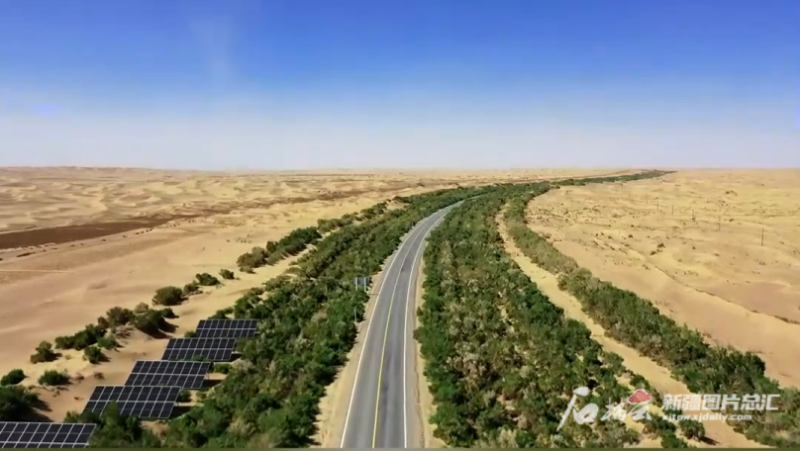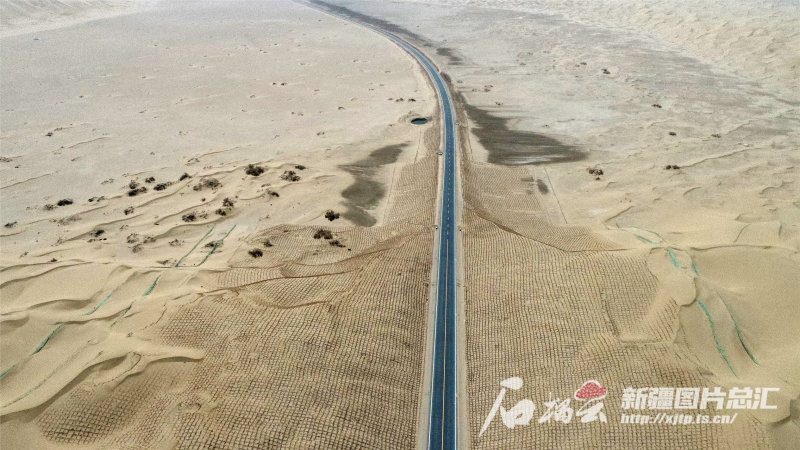Shiliuyun-Xinjiang Daily (Reporter Lu Fengbao) news: In the depths of autumn, it's the perfect time to see desert poplar trees, also known as populus euphratica. Visitors drive along the desert highway into the Taklimakan Desert, taking in the majestic beauty of the poplar trees.
Since the 1990s, northwest China’s Xinjiang has started building highways through the Taklimakan Desert, pioneering long-distance graded highway construction in shifting deserts in China and around the world.
Over the years, the Taklimakan Desert Highway has grown from one to several routes, forming the largest number and widest coverage of desert highway transportation network in China, making travel easier for people in Xinjiang, especially those living in the desert's edge areas.
The "Sea of Death" is no longer impassable
The Taklimakan Desert, often referred to as the "Sea of Death," is the largest desert in China and ranks as the tenth largest in the world. It spans over 330,000 square kilometers, which is approximately 20 percent of the Xinjiang Uygur Autonomous Region's total area. The saying "No birds in the sky, no grass on the ground" aptly describes this vast and inhospitable landscape.
The Taklimakan Desert stretches approximately 1,000 kilometers from east to west and about 400 kilometers from north to south, acting as a formidable barrier that isolates the southern regions of Xinjiang and hampers their economic and social progress.
Located right in the heart of the southern edge of the Tarim Basin, Minfeng County in Hotan Prefecture is bordered by the majestic Kunlun Mountains to the south and the vast expanse of the desert to the north. In the past, for the people of Minfeng to travel to Urumqi, they had to embark on a lengthy detour along National Highway 315 to the west, covering a distance of over 2,200 kilometers, which was both time-consuming and laborious.

File photo shows a road of the Minfeng section of the Luntai to Minfeng highway in northwest China’s Xinjiang Uygur Autonomous Region.
The first highway across the Taklimakan, running 522 km from Lunnan, in the north, to Minfeng county, in the south, commenced construction in March 1993. Spanning 552 kilometers in length, with 446 kilometers through shifting sands, this highway was completed and opened to traffic in September 1995. Since then, the travel distance from Minfeng to Urumqi has been reduced by over 1,000 kilometers.
Subsequently, more highways have been constructed through the "Sea of Death," with the courageous people of Xinjiang conquering the desert with their own steps.
In October 2007, the Alar to Hotan Highway, stretching nearly 425 kilometers, was opened to traffic. On June 30, 2022, the highway, connecting Yuli County and Qiemo County, spanning 334 kilometers, was completed and put into service. Following that, by December 2023, the 276-kilometer-long highway connects the city of Tumxuk with the city of Kunyu, was also completed, bringing the total number of arterial highways traversing the "Sea of Death" to four.
Building on the foundation of the north-south oriented desert highways, the people of Xinjiang have also constructed the highway from Alar City to Tazhong Town in Qiemo County within the Taklimakan Desert. This highway extends diagonally, linking several other desert highways, creating a network within the desert. The vast and boundless desert can no longer serve as a barrier to hinder people's travel and communication as it used to.
Leveling sand dunes to build a smooth road
Constructing a desert highway entails overcoming numerous challenges, and the Yuli-Qiemo Highway presents some of the greatest difficulties among them.
The Yuli-Qiemo Highway stretches for 334 kilometers in total, with a desert section spanning 307 kilometers. Compared to previous desert-crossing roads, constructing the Yuli-Qiemo highway is even more challenging. The road traverses the densely populated and towering sand dunes of the eastern desert, and the difficulty increases the deeper you go.

File photo shows the construction site of the Yuli-Qiemo Highway in northwest China’s Xinjiang Uygur Autonomous Region. (Photo by Shiliuyun-Xinjiang Daily/Han Liang)
The entire project involved leveling 32 massive sand dunes and filling in 28 interdune depressions. The tallest sand dune reached nearly a hundred meters, and it took more than 150 days of relentless work by over 40 high-powered crawler bulldozers to completely flatten it.
Building a highway in the world's second-largest shifting desert is all about tackling the challenge of sand prevention and fixation.
Over a hundred thousand workers have created more than 58 million square meters of straw checkerboards along both sides of the Yuli-Qiemo Highway, using approximately 70,000 tons of reeds. If you laid all these reeds end-to-end, they could circle the Earth's equator about 180 times.
It's not just about building it, but also about protecting and maintaining it.
The desert highway from Luntai County to Minfeng County started its protective forest project alongside its construction to prevent sand erosion. After its completion in 2005, the ecological protection forest belt spans 436 kilometers, with over 20 million salt-tolerant shrubs like saxaul, tamarisk, and jujube planted. Wells are built every 10 kilometers for drip irrigation.
The Yuli-Qiemo Highway has introduced an intelligent warning system for traffic safety. Based on "automatic perception + automatic warning + zero-carbon energy" technology, it uses photovoltaic power, radar detection, wireless transmission, and precise warning technologies to form a self-contained system with certain wind and sand resistance to prevent traffic accidents.
Traveling is now more convenient
The Taklimakan Desert is so vast that it's like a giant wall blocking people's way out. Many locals never get to leave the desert in their whole life. But now, with several desert highways built, people from all ethnic groups can finally say goodbye to being cut off by the desert and start visiting each other more easily.

Photo shows an overlook of the Yuli-Qiemo Highway in northwest China’s Xinjiang Uygur Autonomous Region. (Photo by Cho Hura)
Living in Kuoshiairike Village, Tuogelakeleke Township, Qiemo County, for over 50 years, Yasen Tuerdi rarely goes to Korla City, even though they're both in the Bayingolin Mongolian Autonomous Prefecture. It's mainly because it's not convenient. To get from Qiemo to Korla, he has to first go to Ruoqiang County, then transfer to Korla. The bus ride takes two to three days of bumping along the road.
This situation completely changed after the opening of the Yuli-Qiemo Highway. After the highway was opened, the driving distance from Qiemo to Korla was reduced by 350 kilometers, and the travel time was also shortened from the original 12 hours to six hours. "Now I can just set off for Korla whenever I want," said Yasen Tuerdi.
Statistics from the operation team of Xinjiang Transportation Investment (Group) Co., Ltd. show that since the opening of the Yuli-Qiemo highway, traffic volume has nearly reached 520,000 vehicle trips, making it an important road connection between Korla and Qiemo.
"Before, it would take several days to transport cotton from Qiemo to Korla. After the opening of the Yuli-Qiemo Highway, it only takes six hours for a single trip," said Li Jinjian, a cotton grower in Yuli County.
In Niya Township, Minfeng County, there is a jujube base of Yamei Agricultural Comprehensive Development Co., Ltd., which covers 1,000 mu (about 66.67 hectares). The company operates under a "company + base + farmers" management model. They have planted over 20 varieties of jujube trees. After maturation, the jujubes are mainly sold to Beijing, Shanghai, Guangzhou, Xi'an, Zhengzhou, and other places.
"The desert is no longer a barrier; transporting jujubes is very convenient," said Chen Jianjun, the manager of Yamei Agricultural Comprehensive Development Co., Ltd.
(A written permission shall be obtained for reprinting, excerpting, copying and mirroring of the contents published on this website. Unauthorized aforementioned act shall be deemed an infringement, of which the actor shall be held accountable under the law.)









